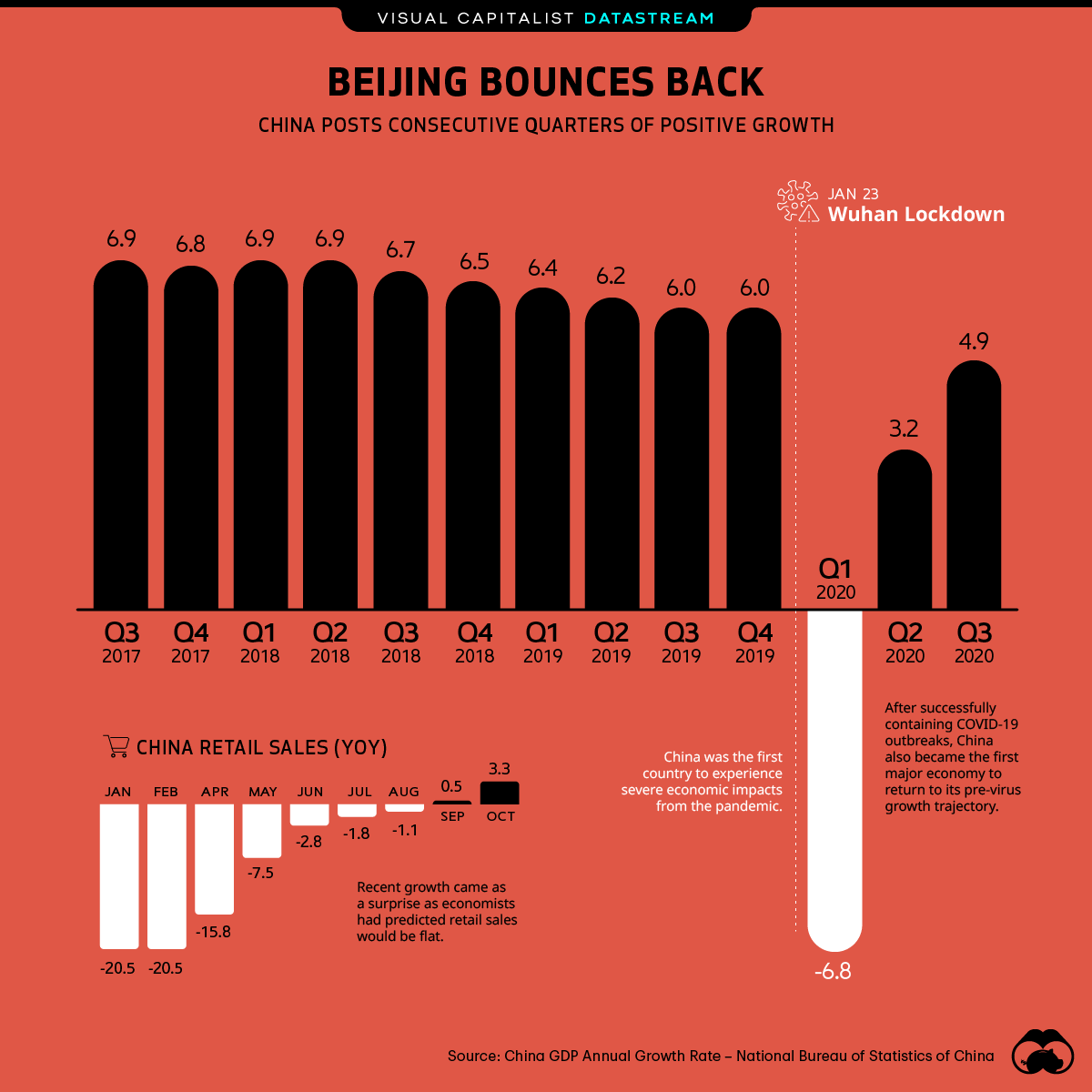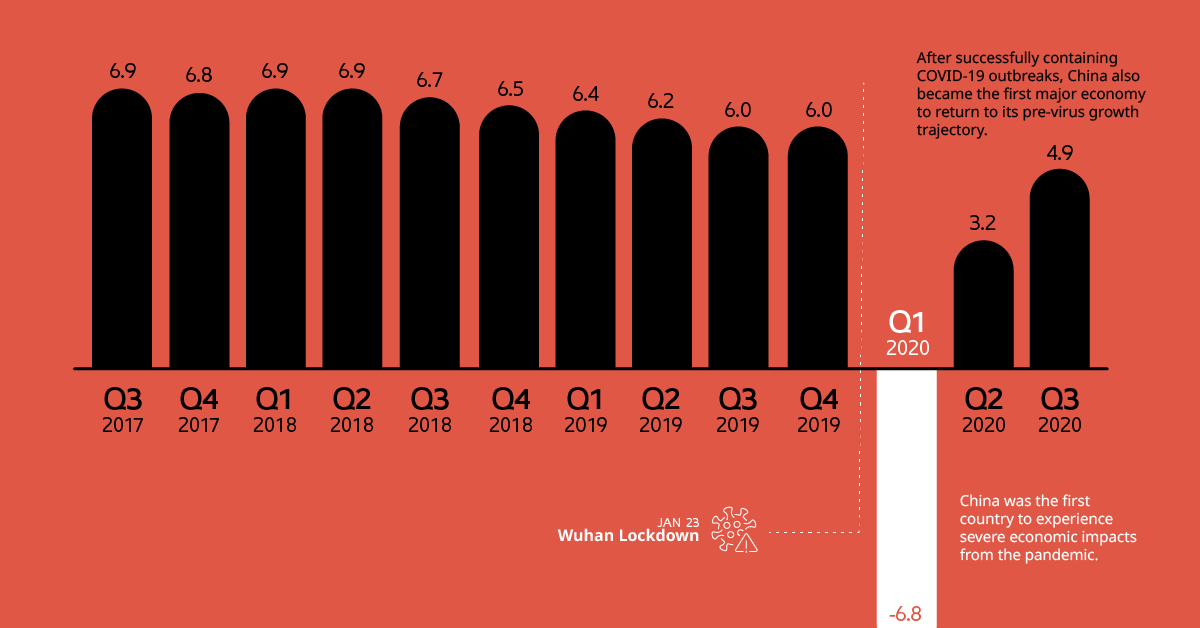Datastream
Beijing Bounces Back: China Posts Positive Q3 Growth Numbers

The Briefing
- The Chinese economy grew by 4.9% year-on-year in the third quarter of 2020.
- Growth for the first three quarters of 2020 is now up 0.7% from a year ago.
China Posts Positive Q3 Growth Numbers
China became the first major economy to return to its pre-virus growth trajectory, posting positive growth numbers in Q2 2020. Now, China’s National Bureau of Statistics has reported third-quarter GDP growth that is up 4.9% from a year ago.
The Road to Recovery
Like the rest of the world, China’s economy took a hit when pandemic-induced lockdowns shut down businesses and factories across the country.
However, the world’s second largest economy was one of the first to put COVID-19 restrictions in place, which could explain why it was the first major country to report growth as stores and factories began to reopen post-lockdown.
Here’s a look at China’s GDP growth in recent times:
| Quarter | China GDP Annual Growth Rate |
|---|---|
| Q3 2017 | 6.9% |
| Q4 2017 | 6.8% |
| Q1 2018 | 6.9% |
| Q2 2018 | 6.9% |
| Q3 2018 | 6.7% |
| Q4 2018 | 6.5% |
| Q1 2019 | 6.4% |
| Q2 2019 | 6.2% |
| Q3 2019 | 6.0% |
| Q4 2019 | 6.0% |
| Q1 2020 | -6.8% |
| Q2 2020 | 3.2% |
| Q3 2020 | 4.9% |
Are These Numbers Good?
Many countries around the world see China as a barometer of what post COVID-19 recovery could potentially look like, so new quarterly numbers have taken on some significance.
Not only did China show a speedy recovery—its initial bounce-back was also higher than predicted. While experts had projected a 2.4% increase between April and June, China’s National Bureau of Statistics reported a 3.2% rise.
Though the 4.9% increase reported in Q3 is good news for China, it still falls short of predictions from Chinese economists of 5.2% growth in the third quarter.
Is it an upward trajectory from here, or will China’s economy experience another dip? The experts have varying opinions, but the majority are relatively optimistic.
If China’s COVID-19 cases remain under control, it’s possible that growth is on the horizon.
Where does this data come from?
Source: National Bureau of Statistics of China
Details: This data was released on October 18th, 2020.
Datastream
Can You Calculate Your Daily Carbon Footprint?
Discover how the average person’s carbon footprint impacts the environment and learn how carbon credits can offset your carbon footprint.

The Briefing
- A person’s carbon footprint is substantial, with activities such as food consumption creating as much as 4,500 g of CO₂ emissions daily.
- By purchasing carbon credits from Carbon Streaming Corporation, you can offset your own emissions and fund positive climate action.
Your Everyday Carbon Footprint
While many large businesses and countries have committed to net-zero goals, it is essential to acknowledge that your everyday activities also contribute to global emissions.
In this graphic, sponsored by Carbon Streaming Corporation, we will explore how the choices we make and the products we use have a profound impact on our carbon footprint.
Carbon Emissions by Activity
Here are some of the daily activities and products of the average person and their carbon footprint, according to Clever Carbon.
| Household Activities & Products | CO2 Emissions (g) |
|---|---|
| 💡 Standard Light Bulb (100 watts, four hours) | 172 g |
| 📱 Mobile Phone Use (195 minutes per day)* | 189 g |
| 👕 Washing Machine (0.63 kWh) | 275 g |
| 🔥 Electric Oven (1.56 kWh) | 675 g |
| ♨️ Tumble Dryer (2.5 kWh) | 1,000 g |
| 🧻 Toilet Roll (2 ply) | 1,300 g |
| 🚿 Hot Shower (10 mins) | 2,000 g |
| 🚙 Daily Commute (one hour, by car) | 3,360 g |
| 🍽️ Average Daily Food Consumption (three meals of 600 calories) | 4,500 g |
| *Phone use based on yearly use of 69kg per the source, Reboxed | |
Your choice of transportation plays a crucial role in determining your carbon footprint. For instance, a 15 km daily commute to work on public transport generates an average of 1,464 g of CO₂ emissions. Compared to 3,360 g—twice the volume for a journey the same length by car.
By opting for more sustainable modes of transport, such as cycling, walking, or public transportation, you can significantly reduce your carbon footprint.
Addressing Your Carbon Footprint
One way to compensate for your emissions is by purchasing high-quality carbon credits.
Carbon credits are used to help fund projects that avoid, reduce or remove CO₂ emissions. This includes nature-based solutions such as reforestation and improved forest management, or technology-based solutions such as the production of biochar and carbon capture and storage (CCS).
While carbon credits offer a potential solution for individuals to help reduce global emissions, public awareness remains a significant challenge. A BCG-Patch survey revealed that only 34% of U.S. consumers are familiar with carbon credits, and only 3% have purchased them in the past.
About Carbon Streaming
By financing the creation or expansion of carbon projects, Carbon Streaming Corporation secures the rights to future carbon credits generated by these sustainable projects. You can then purchase these carbon credits to help fund climate solutions around the world and compensate for your own emissions.
Ready to get involved?
>> Learn more about purchasing carbon credits at Carbon Streaming
-

 Real Estate2 weeks ago
Real Estate2 weeks agoVisualizing America’s Shortage of Affordable Homes
-

 Technology1 week ago
Technology1 week agoRanked: Semiconductor Companies by Industry Revenue Share
-

 Money1 week ago
Money1 week agoWhich States Have the Highest Minimum Wage in America?
-

 Real Estate1 week ago
Real Estate1 week agoRanked: The Most Valuable Housing Markets in America
-

 Business2 weeks ago
Business2 weeks agoCharted: Big Four Market Share by S&P 500 Audits
-

 AI2 weeks ago
AI2 weeks agoThe Stock Performance of U.S. Chipmakers So Far in 2024
-

 Misc2 weeks ago
Misc2 weeks agoAlmost Every EV Stock is Down After Q1 2024
-

 Money2 weeks ago
Money2 weeks agoWhere Does One U.S. Tax Dollar Go?















